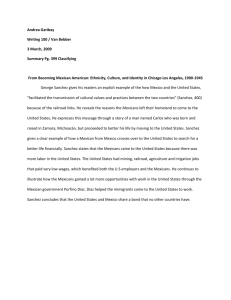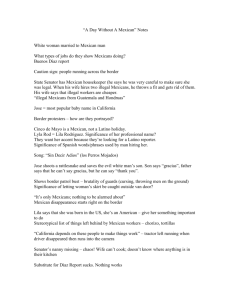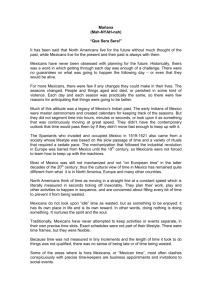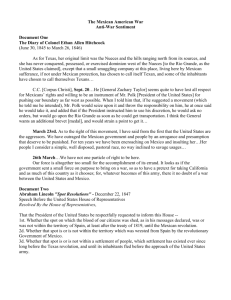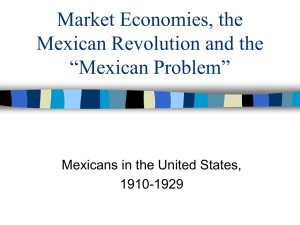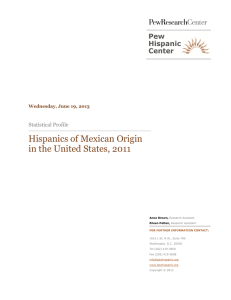Working with Mexicans
advertisement
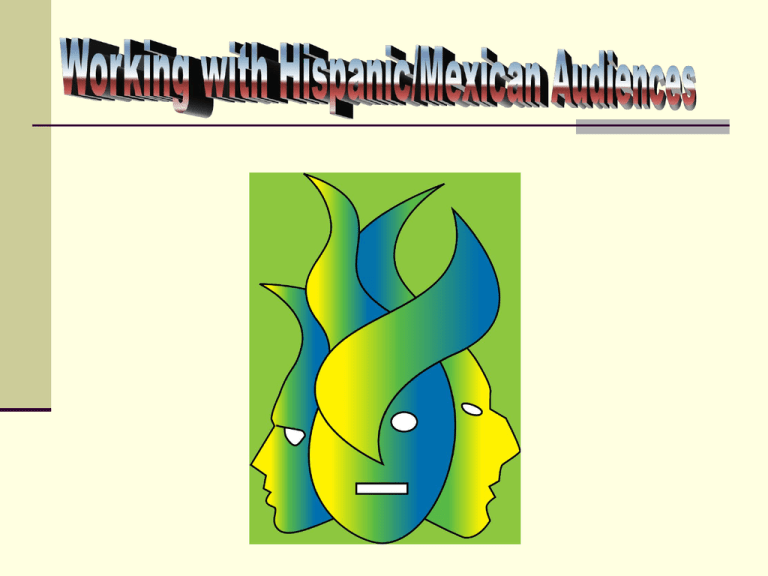
Hispanic Growth in WA State 8.5% (517.055) of the population – 2006 Largest minority group Estimated 626.349 with median age 24.84 – 2010 28% of immigrating population Foreign born increased by 300% between 1990 and 2000 Does everyone in Latin America eat Tortillas? Individualized Consideration Hispanic is not a race but an ethnic distinction Hispanics come from all races and physical traits People from Latin America are all Latin but not all are Hispanics An Elitist Society Mexican society is sharply divided by income and educational level. Although a middle class has struggled to expand in the cities, the principal division is between the wealthy, well-educated elite and the urban and rural poor, who constitute the vast majority of the population Stages of Mexican Culture in the US 1) Recent Arrivals (1st Generation – Mexicans) - Don’t speak English - Hold fast to traditional roles - They are half of all Latinos in the US - Born in other countries - Average formal education of 9 years 2) Bi-Cultural (2nd and some 3rd Generations – Chicanos) - Know English - Accept quickly the American culture 3) Most assimilated (3rd, 4th and so on Generations) - 25% of Latinos - Fully functional in English - Capable of participating in the full range of mainstream American life Mexicans and Chicanos are not the same - They are representatives of very different cultures - They have plenty in common, as, for example, do Americans and Canadians But their differences are important and must be respected - The most common conflict is between Mexican parents and their Chicano children, who leave behind the culture of their parents as they adapt to American culture - HISPANICS CAN'T BE 9/11 TERRORISTS BECAUSE... 8:45am is too early for us to be up. We are always late so we would have missed all 4 flights. Pretty people on the plane easily distract us. We would talk loudly and bring attention to ourselves. With food and drinks on the plane, we would forget why we were there. 6. We talk with our hands so we would have to put our weapons down. 7. We would ALL want to fly the plane. 8. We would argue and start a fight on the plane. 9. We can't keep a secret so we would have told everyone a week before doing it. 10. We would have put our country's flag on the windshield of the plane. 1. 2. 3. 4. 5. Cultural Values and Concepts Individualism Perspective is based on the individual Defines people by their work Glorifies the person who works hard to get ahead Collectivism Family-oriented society Defines people by their family Glorifies the person who works hard to get his family ahead The family needs must be accommodated first Extreme of the Spectrum Individualistic: 1) United States 2) Australia 3) Great Britain 4) Canada 5) New Zealand Collectivistic: 1) Venezuela 2) Colombia 3) Pakistan 4) Peru 5) Taiwan Hofstede ’84 Cultural Values and Concepts Authority Americans Not good at accepting limits Strong supporters of education, the “great equalizer” Values democracy, the majority rules Higher degree of citizen participation Mexicans Traditional Mexican respects authority. They don’t challenge them Authoritarian system of government (72-year domination by the PRI party) Strong Classicist System The boss rules; the majority follows him Lower degree of citizen participation Expects bosses and supervisors to be strong and decisive Not to be authoritative and dictator is a signal of weakness or lack of knowledge Cultural Values and Concepts Respect (Usted y Tu) Americans It is relative and important Respect is something that must be earned Less concerned about personal honor More tolerant Mexicans It is absolute and fundamental (similar to Asians) It is the cornerstone of their culture Everyone deserves respect – we are all children of God A persons doesn’t need to do nothing to get respect – but he/she can loose it They have a strong sense of personal honor – He/she will not allow any encroachment on the boundaries he/she has set It becomes pretty easy to offend them Cultural Values and Concepts Fatalism Americans Focused on the future See death as an enemy Non conformist Planner Tend to be punctual Functions in as faster pace Mexicans Focused on the past and the present Accept what is, even when they shouldn’t Mexican culture places high value on aguente (ability to put up with things, to deal with life) The complainer is often dismissed as a chillon (cry baby) Prefer to improvise rather than plan Tend to not be punctual. (the majority prefer to live life day by day). Functions at a slower pace, with less attention to time Cultural Values and Concepts Siesta / Concept of Time Americans It is focused on the future Time is money Native of a country that has no tropical zones ½ hr Lunch. Leave work around 5 p.m. See the Siesta as depicted by Hollywood – the lazy Mexican Mexicans Have a different perspective about time and deadlines It is focused on the present and past They prize the moment Used to the tropical or Colonial work schedule Leave work around 7 p.m. Have a strong work ethics Cultural Values and Concepts Singling Out Americans Competitive Determined to win An honor to be singled out Like to have achievements praised Value self-esteem, confidence, capability, and pride Mexicans Product of a society that place the rights of the group above the rights of the individual Singling out an individual is seen as egotism Praise is given for cooperation with the group Prefers to remain a member of the group, even if it means passing up a promotion Finds it difficult to brag about himself; shows poor education (mal educado) Doesn’t like to stand out, even to receive praise Less interested in having their pictures or quotes in the paper Cultural Values and Concepts Education Americans The main purpose of the educational system is to teach academic concepts “Is he getting good grades?” a badly educated or uneducated person is someone who is lacking in academic concepts; and the fault lies with the educational system Mexicans Hispanic students drop out more than any other ethnic group Usually after the 9th grade, when the student turns 14 The family need is more important than the individual need “Is he behaving himself?” The main purpose of the educational system is to teach respect; to instill in children the norms of acceptable behavior. To be “badly educated” (mal educado) is to be disrespectful; to show bad behavior. The fault lies with the parents. Cultural Values and Concepts Being Sorry Americans The magic words - with one simple phrase they excuse themselves for just about anything Learn from an early age that they can get away without having to explain themselves When adults they absolutely must hear it to conclude just about any conflict or disagreement Mexicans Rarely say “lo siento” in order to resolve a misunderstanding “I’m sorry” are powerful words for him, because they may put his personal honor at risk Those words don’t come nearly as easily for him as they do for his American neighbor Hear the phrase as insincere, and prefer an explanation Body Language Gestures of disrespect Point things out, including people, with index finger. That’s how you point at dogs or other animals, but never people! Snapping the fingers Reserved only to animals Whistling Reserved for good friends. Otherwise, it is a sound of rejection Yelling Who does is usually angry about something Looking in the eye Avoidance of eye contact is a sign of respect. Handshake A soft one show peaceful intentions by means of an empty hand. Turning down an offer is an insult; a snub; a rebuff; a slight. Suggestions how to work better with Mexicans 1. Attend to the matter of respect (the very word “respect” is strong medicine in Mexico) Greet every person, including the kids Ask permission rather than give orders (Would you like to have a seat?). Respect their silence and closed nature Accept offers of food and drink, or give a medical excuse for rejecting it. When you must criticize, do it with positive statements. Never, make fun of, or laugh at, a Mexican Remember gestures that may be offensive 2. They expect equal, not special, treatment Don’t single out them just for being one (“That Mexican teacher is pretty good.”). Remember that not all Mexicans think alike (there are republicans, democrats, liberals, conservatives, etc) 3. Be aware of their sense of inferiority Don’t feel guilty about it; this comes from the deep past. Don’t try to make up for it. Speak calmly and listen attentively. Avoid being too critical, and stay positive. Suggestions how to work better with Mexicans 4. Respect gender and family relationships Give special deference to the man of the house The oldest son is “dad” when Dad, and the oldest daughter is “mom” when parents aren’t home The youngest son is the “baby,” no matter how old he is Remember the high tolerance they show toward smaller children 5. Stretch your time frame. They have a different perspective, and may not meet deadlines very well 6. Don’t be quite so open about yourself, or expect openness of feelings from them 7. On body language Avoid the firm handshake and prolonged eye contact Until you achieve a pretty good understanding, avoid humor Lower the tone, and particularly the volume, of your voice Suggestions how to work better with Mexicans 9. Personalize! Make friends with a real live Mexican and talk about culture 10. Learn to identify stereotypes and avoid their use. Almost nothing can be said about all Mexicans 11. Respect the language barrier Remember that a lack of English does not indicate a lack of intelligence. 13. Make an effort to pronounce correctly your Mexican neighbor’s name. 14. Take seriously the need for diversity among your friends and co-workers. Resist the temptation to surround yourself with people just like you Remember that the “different” ones among us give us strength and help us grow 15. At the beginning and at the end of everything is the concept of respect. When in doubt, apply the Golden Rule – treat others as you would like to be treated The comparing part and suggestions in this presentation were based on the book: Uncomfortable Neighbor – Cultural Collisions between Mexicans and Americans By James V. Tiffany To order copies of the book: El Mundo Communications, Inc. P.O. Box 2231 Wenatchee, WA – 98807 (509) 663-5737; (509) 663-6957 Elmundo1@nwi.net

